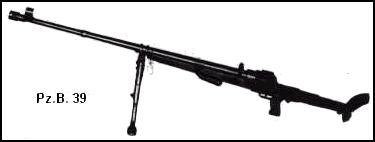Panzerbüchse 38
(“Tank Rifle”), often abbreviated as PzB 38, conceived by Dipl.-Ing. (certified engineer) B. Brauer and built by the Gustloff-Werke in Suhl. It was a manually loaded single shot weapon with moving barrel. When fired, the barrel recoiled about 9cm, which opened the breech and expelled the spent cartridge. The breech block was then arrested in the rear position, leabing an opening for the gunner to manually insert a new cartridge. The gunner then released the cocked breech with a lever at the grip. breech and barrel then glide forward again and the trigger is cocked. The weapon is ready to fire again. This rather complicated mechansim was reportedly prone to jamming if the system got dirty in field use.
The weapon uses the bipod found on the MG 34; the shoulder plate is rubber-cushioned and can be folded to the right for ease of transportation. Although manufactered with pressed steel parts that were spot-welded, still because of the complicated vertical block breech mechanism it was difficult to manufacture and only the small number of 1408 PzB 38 was built from 1939 to 1940 at the company Gustloff Co. Waffenfabrik in Suhl; 62 of these weapons had been used by the german troops in the invasion of Poland 1939. As soon as the successor PzB 39 was available immediately production was switched over to the new type. The weapon had an overall length of 161.5 cm (129cm with the stock folded for transportation) and a barrel (4 grooves rs) length of 108.5 cm. Total weight (incl. bipod and carrying sling) 16.2 kg, weight of barrel (incl muzzle brake) 6.14kg; Vo using the Patrone 318 was 1,210m/s which made for a penetration of 30mm at 100m.



























